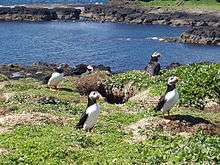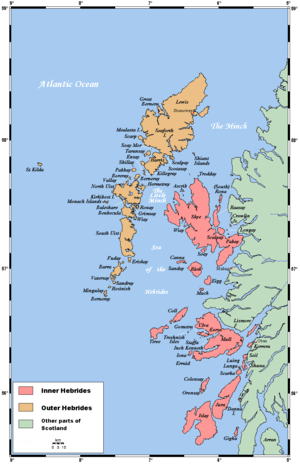Lunga, Treshnish Isles
The island of Lunga is the largest of the Treshnish Isles in Argyll and Bute, Scotland, which form part of the Loch Na Keal National Scenic Area.
| Gaelic name | Lungaigh |
|---|---|
| Norse name | langr-øy |
| Meaning of name | "(long)ship island", from Norse |
| Location | |
 Lunga Lunga shown within Argyll and Bute | |
| OS grid reference | NM278419 |
| Coordinates | 56.49°N 6.42°W |
| Physical geography | |
| Island group | Treshnish Isles |
| Area | 81 ha (3⁄8 sq mi) |
| Area rank | 161 [1] |
| Highest elevation | Cruachan, 103 m (338 ft) |
| Administration | |
| Sovereign state | United Kingdom |
| Country | Scotland |
| Council area | Argyll and Bute |
| Demographics | |
| Population | 0 |
| References | [2][3][4][5][6] |
History
Of volcanic origin, Lunga has been described as 'a green jewel in a peacock sea'.[3] Populated until the 19th century, Lunga still bears the remains of blackhouses. To the northeast of the island lie the remains of the ruined village, which was abandoned in 1857.[7]
Wildlife

.jpg)
As one of the Treshnish Isles, Lunga carries the designation of an Site of Special Scientific Interest, a Special Protection Area and a Special Area of Conservation[8]. These designations reflect the importance of the islands for breeding colonies of sea birds and its marine life. Many rare and endangered plants are native to the island. Plants include primrose, birdsfoot trefoil, orchids, sea campion, sea thrift, sea pinks, yellow flags, tormentil and oyster plant.[3] Grey seals inhabit the waters surrounding the island, while birdlife including storm-petrels, kittiwakes and Manx shearwaters, guillemot, puffin, European shag and razorbills breed on Lunga and on the Harp Rock, a sea stack separated by a narrow gut. Barnacle geese appear each winter.[3]
In summer, tourist boats visit Lunga from Tiree, Tobermory, Iona and Ardnamurchan. The main attraction is the many thousands of breeding puffins which allow visitors to approach to within a few feet of them.
Footnotes
- Area and population ranks: there are c. 300 islands over 20 ha in extent and 93 permanently inhabited islands were listed in the 2011 census.
- 2001 UK Census per List of islands of Scotland
- Haswell-Smith, Hamish (2004). The Scottish Islands. Edinburgh: Canongate. ISBN 978-1-84195-454-7.
- Ordnance Survey
- Iain Mac an Tailleir. "Placenames" (PDF). Pàrlamaid na h-Alba. Archived from the original (PDF) on 2011-09-26. Retrieved 2007-07-28.
- "Regions of Scotland and Gaelic Names" (PDF). Retrieved 2007-08-01.
- "Overview of Lunga". Gazetteer for Scotland. Retrieved 2007-07-28.
- "Treshnish Isles". Wild About Lochaber. Retrieved 2020-05-22.
External links
| Wikimedia Commons has media related to Lunga, Treshnish Isles. |
